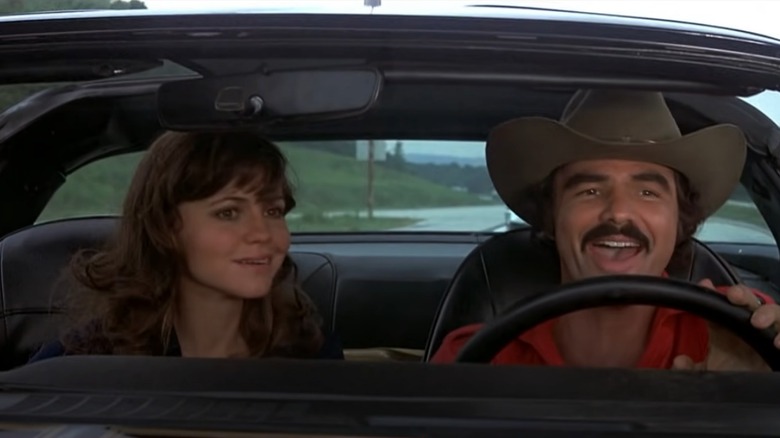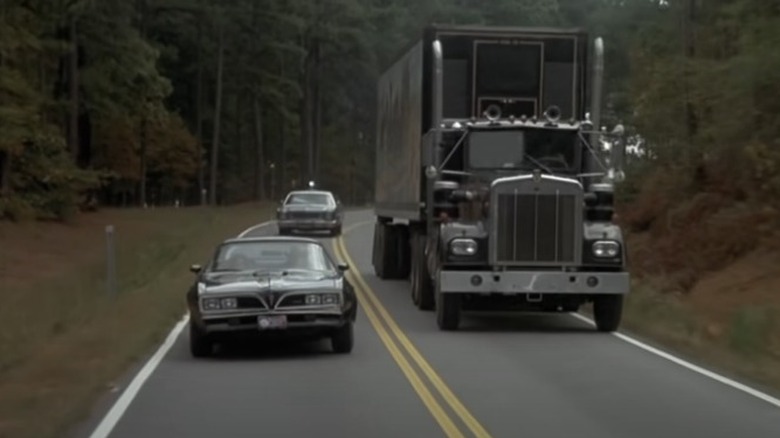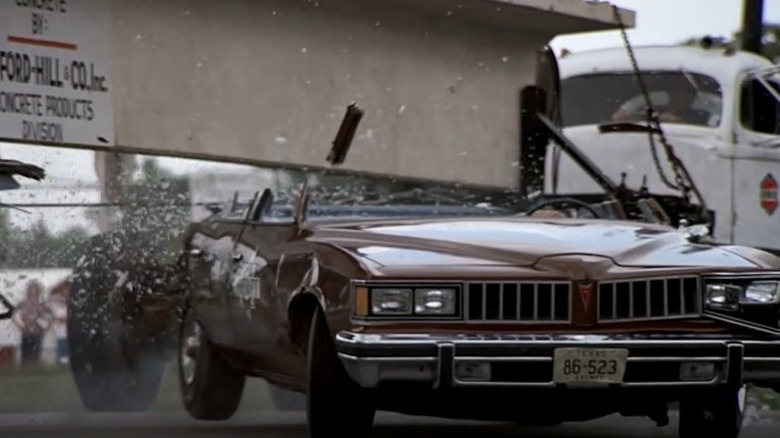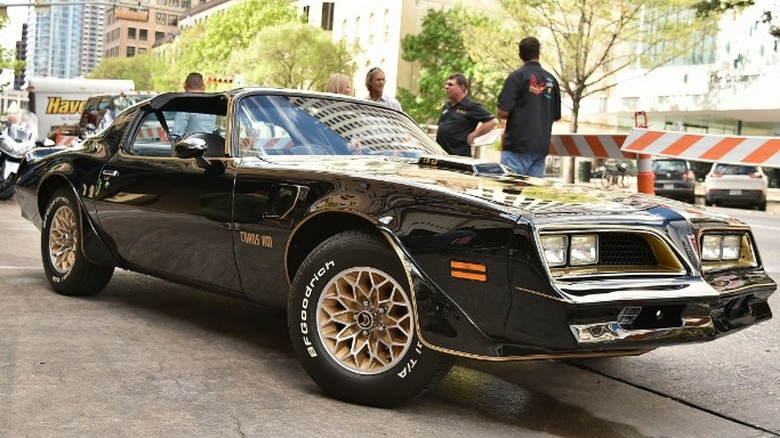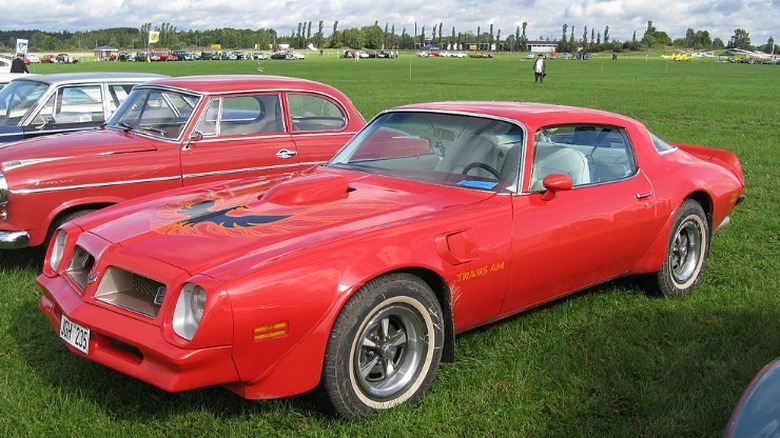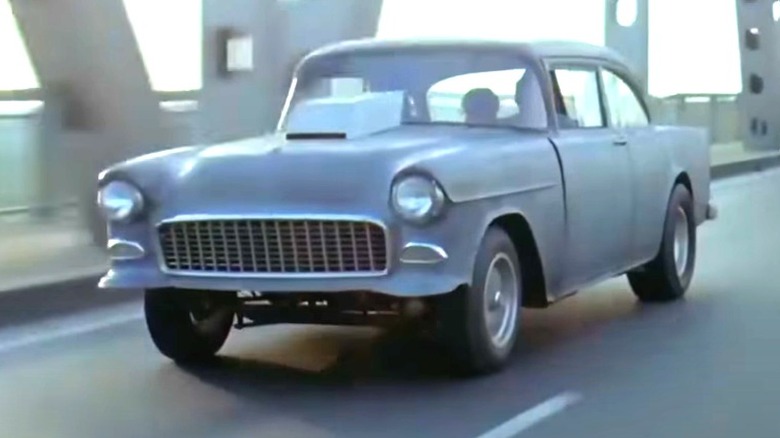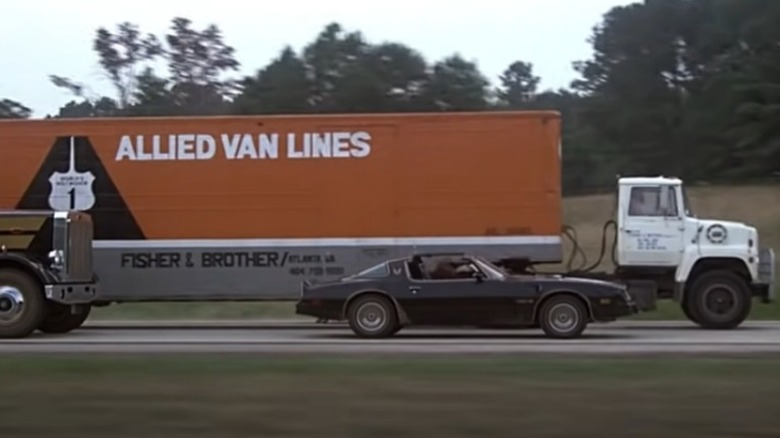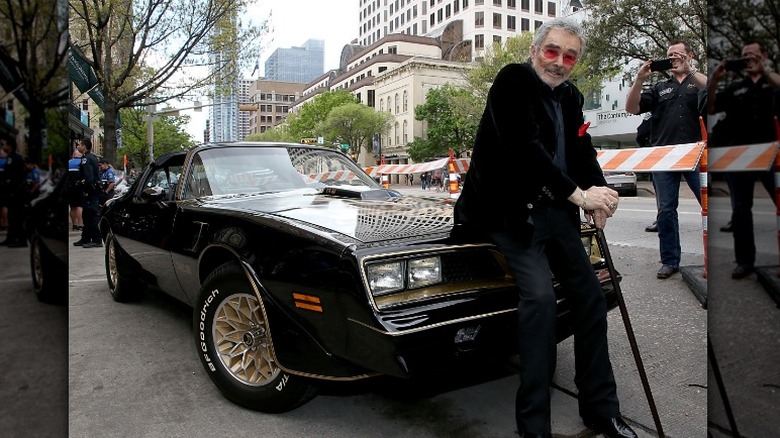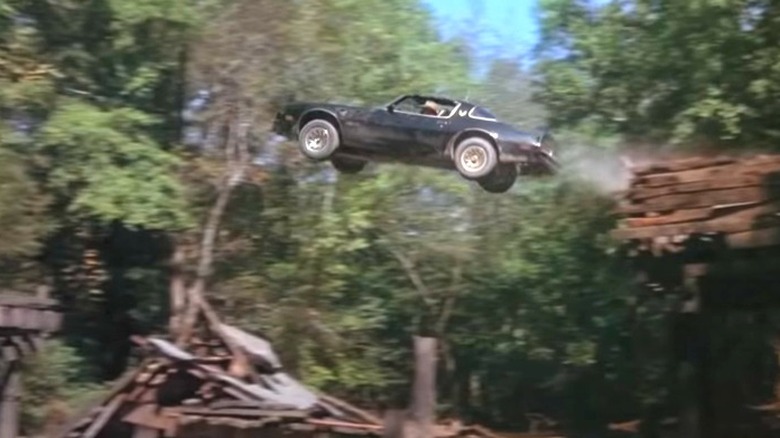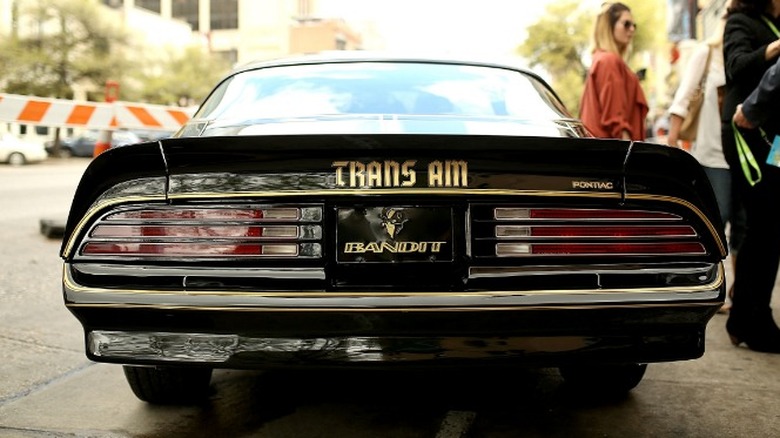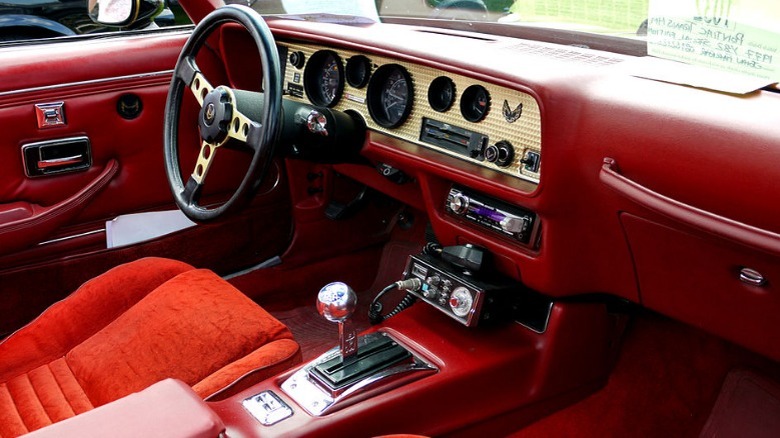10 Facts About Smokey And The Bandit's Iconic Pontiac Trans Am
Few films from the late '70s have the enduring legacy that "Smokey and the Bandit" does. It kind of has everything a good movie needs from fast cars, to pretty girls, beer to bumbling police, daring escapes, and an ending where the outlaw gets away. Furthermore, the casting choices owe heavily to its success. Burt Reynolds was in his prime and served as the perfect heartthrob, while the legendary Jackie Gleason could not have been better as a comic foil. Sally Field's innocent girl-next-door quality didn't hurt much either.
For those not old enough to remember switching cable channels on a box with a 30-foot cord tethered to the TV, "Smokey and the Bandit" is a 1977 film featuring an adventurous run across the American south by a couple of truckers trying to get a haul of Coors beer to Atlanta to collect $40,000. At the time, Coors was only available in the West as it was unpasteurized and couldn't be shipped cross-country. While Bandit never actually drives a truck in the film, he does escort his buddy played by country star Jerry Reed, who wrote and recorded the theme song, in a fresh and shiny 1977 Pontiac Trans Am fitted with a 6.6-liter V8. To make it in time, the duo has to contend with Sheriff Buford T. Justice, aka Smokey, and his dimwitted deputy son, avoiding arrest for hauling contraband across state lines. The movie was a smash hit and is still a favorite today, especially among gearheads and fans of mustaches. That said, here are 10 facts about the iconic Pontiac Trans Am from Smokey and the Bandit.
Pontiac provided the cars for free
"Smokey and the Bandit" was Hal Needham's directorial debut, but he had been a working movie stuntman for years prior and was a Hollywood veteran already. He was also friends with Burt Reynolds, whose involvement with the film helped ensure its eventual release. According to Motor Trend, Needham originally cruised the Universal Studio Transportation Department lot to find the perfect car for the movie's antihero, the Bandit. After seeing a selection of Ferrari, Lamborghini, and other exotic models available, he knew none of these would fit the character. As the Bandit was a working man from the south, he could only have him in something built from American steel with the iconic American V8 under the hood.
It was at this time Needham happened to be looking through a new car magazine that a black and gold Pontiac Trans Am struck him and he knew that would be the perfect car for the movie. He called Pontiac to pitch the idea and got an agreement to receive cars for filming at no charge.
It was not really a fast car
A Trans Am was chosen for the Bandit to drive because it was a V8-powered muscle car that looked exceedingly cool. Nobody can argue that a 1977 Trans Am looks cool, but the performance figures are less than impressive. By 1977, EPA regulations for automobiles were in full effect and the heyday of the muscle car with huge horsepower figures was long gone.
Choking engines with anti-smog equipment along with a lack of sophisticated computerized controls left a 6.6-liter V8 Trans Am with nothing more than 200 horsepower.
For comparison, a 2019 Ford Taurus family sedan with a 3.5-liter V6, almost half the size of the V8, outputs 288 horsepower. The Trans Am torque rating was still a respectable 325 ft-lb, but that performance still pales in comparison to today's sports cars and barely competes with modern family haulers. In the end, none of that matters much on screen as long as Burt Reynolds looked cool in the car, and he accomplished that in spades.
Multiple cars were used
The interwebs hold differing facts about how many cars were used in the film. Because of the nature of the driving in the film, damage and wear to the cars was inevitable. Pushing a car to the limit, no matter how powerful and well-built it may have been, was not good for it. And this movie had cars being hitting limits throughout. Furthermore, some scenes were shot with cars bumping up against other cars and objects, and there's no way the scene jumping the Mulberry bridge didn't cause significant body damage. Also, driving cars off-road at high-speed tears up the suspension, especially on a low-slung sports car.
While answering an audience question in a video from Comicbook.com, Burt Reynolds said that 12 cars were used in the course of making the movie and that he figures he ruined a good portion of them. However, Fortune notes that producer Hal Needham had asked Pontiac for six cars but only received four, and one of them was to be used for promotional purposes. In the sequal, however, Needham requested 10 Trans Ams and 55 Bonnevilles, which were given no questions asked, according to Hagerty. Whether to believe other accounts or Burt Reynolds depends on whether you believe official records or the legend himself.
It was not a 1977 model
While the stars of the movie went by names such as Reynolds, Fields, and Gleason, everyone knows the real celebrity was the 1977 Pontiac Trans Am. The thing about that is the movie came out in May of 1977 but was filmed a year before when Pontiac only had 1976 models in the showroom. While it can be easy to show one car as a model from another, 1977 saw a revised model with a significantly different grille, headlight, and other features.
This is the sort of problem that comes up often when including a new car model in the movies, including James Bond. To prevent the Bandit from running from Sheriff Justice in last year's model, Pontiac altered 1976 model cars with custom parts to make them look like the upcoming car (via Car Parts). The cars used were the 1976 Special Edition, which already came in black with gold accents, and the infamous "screaming chicken" decal on the hood. With a new quad-headlight bumper and a couple of other cosmetic touches, audiences were none the wiser that the car on-screen was outdated by a year.
[Featured image by nakhon100 via Wikimedia Commons | Cropped and scaled | CC BY 2.0]
It wasn't Trans Am enough
Getting a group of actors on a set with various props and dialogue onto film and processed to a point that you see it on screen as a feature film takes a lot of work. Furthermore, everything in the finished product has to be meticulously orchestrated and edited or it can be panned by critics, shunned by audiences, and picked apart by fans.
What this means is that what you see on screen and what you hear from the speakers often, if not usually, were not recorded at the same time. This is true of dialogue and sound effects, which can both be recorded after filming in a controlled environment with no risk of picking up additional sounds and making it onto the track. Also, by the late '70s, Pontiac was making cars that adhered to a number of federal regulations and were built to suit consumer tastes. Therefore, a brand-new Trans Am emitted a relatively mellow rumble from its exhaust.
The car used by audio engineers was a custom 1955 Chevrolet hardtop. It had been driven in the 1971 movie Two-Lane Blacktop by both Beach Boy Dennis Wilson and singer James Taylor. It was later used by the pre-Star Wars – another hit movie released the same week as Smokey and the Bandit – George Lucas classic American Graffiti, according to Sports Car Market. It was powered by a big block V8 and most likely had a big free-flowing exhaust with a loud V8 growl perfect for film. The car sold in 2015 for $159,500.
All the movie cars are gone
While certain screen-used movie cars can be seen at certain museums, displayed within public attractions, or end up in private hands as highly valuable collectors' items, the Bandit's Trans Ams are no more. As previously mentioned, filming an adventure car film with a generous helping of high-speed driving and general motoring hijinx puts a toll on a car, and Burt Reynolds – and his stunt drivers – put these cars through the wringer.
Although Reynolds said a dozen cars were used and several were destroyed, other accounts say that all of the screen-used cars were driven into the dirt and were basically totaled by the end of filming, according to Motorious. It is also said that one of the last cars remaining by the end of filming had to be pushed into place for filming the last shots scheduled because it would no longer run. However, the fourth car Pontiac gave the production company to use for promotional purposes was not destroyed. It was sold at Barrett-Jackson in 2016, but the price is not published.
Reynolds' Trans Am recently sold
Burt Reynolds himself owned a 1977 Pontiac Trans Am Special Edition. His was equipped with the 6.6-liter V8 that came from the factory with a whopping 180 horsepower and also had T-tops, air conditioning, and an automatic transmission. The car was given to Reynolds by Pontiac as a gesture of appreciation for his work in promoting the car when the movie came out. Reynolds owned the car and kept it at Reynolds Ranch in Jupiter, Florida, until his death in 2018. Ownership then transferred to his friend Gene Kennedy, who said Reynolds wanted him to have it and display it to preserve the legacy, Fox 13 reported.
He apparently chose to pass it on as it went up for auction at Barrett-Jackson in 2022. The car, which had undergone a thorough restoration in 2015, sold for a final bid of $495,000, far exceeding the price of any other 1977 Trans Am, regardless of condition.
Jumping the Mulberry Bridge
Performing stunts for the camera is a tricky business. Modern movie producers have the benefit of advanced CGI to create any kind of stunt or situation that they can conjure from their heads. But in 1977, things had to be done the old-fashioned way — the only way to film a car jumping an old and defunct bridge was to jump a car over that bridge.
While the Trans Am had plenty of torque to get it going, and enough horsepower to get it to speed with enough road to get there, gravity is still a powerful force to overcome. Therefore, to film the scene jumping over the Mulberry Bridge, the Bandit's Pontiac needed a boost. Multiple sources online claim that the stunt crew added rocket boosters to get it over the gap. However, Hagerty reports that director Hal Needham himself said the car was outfitted by a NASCAR garage with a 700 horsepower engine and manual transmission. That would give it plenty of juice to make the jump. He also claimed that the car looked like a camel when it was finished.
Bandit was a coup for Pontiac
Product placement is an old tradition in media, and many companies would insert theirs into film and radio even before televisions came along. By the 1970s, this was a common practice. For Pontiac, having one of its models in a popular movie was kind of a no-brainer. However, Hal Needham was a novice director and the success of the movie was not guaranteed, although having Burt Reynolds as the star was a good indicator. That is why Pontiac agreed to offer some cars, limited in number.
It turns out that this move was a rousing success for the automaker. Smokey and the Bandit went on to be a summer blockbuster and one of the most popular films of the era, despite going up against Star Wars on opening weekend. The movie ran in syndication showing up as a Saturday night movie on network channels and would feature regularly on the new network channel HBO. Auto industry expert John McElroy, speaking about the film, says that putting a car in a movie is better than almost any advertising (via Detroit Free Press). The total sales volume of Trans Ams sold is proof. Trans Am World lists total sales figures for 1976 at 46,701 increasing to nearly double at 67,745 the next year, with peak sales happening in 1979 at 117,108. Pontiac owed a debt of gratitude to this edgy and action-filled flick.
Factory installed radio
Integral to the plot is the communication between the Bandit and Cledus, who uses the handle Snowman on the radio. In the age before mobile phones, CB radios were the best way to communicate on the road, and that is why they have been the choice of long-haul truckers for decades. They also saw a surge in popularity in the '70s, showing up in pop culture in many places, such as "Smokey and the Bandit."
What a lot of people may not know is that Pontiac offered a CB radio as an official accessory. Likely, the Bandit used a CB that came in the car straight from the dealer. These were offered by auto manufacturers for a short time in the '70s, and Autoweek wrote about them, showing that Cadillac offered combo radio that included AM, FM, and CB with handset. The Bandit likely used the CB radio that came from the dealer installed in the pocket at the front of the console, but it may have been aftermarket, according to We Are CB. Other cars at the time could be had with an in-dash radio with the CB integrated, such as the $560 option from Cadillac, Autoweek notes. The CB radio use continued through all the Bandit movies but the popularity waned shortly thereafter.
[Featured image by Mic via Wikimedia Commons | Cropped and scaled | CC BY 2.0]
